Irrational Number Line Games, LLC
free-stuff stuff-to-buy about-us home contact
Archive
To the Archive IndexAtlantis Sinking!
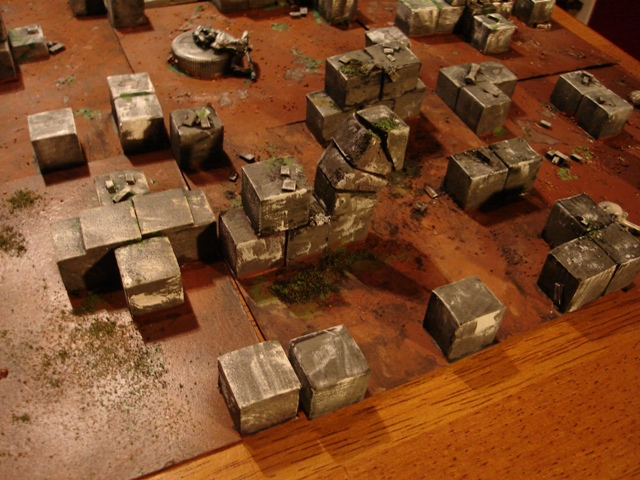 Atlantis is such a powerful motif, that we decided it deserves *two* ideas this
week. First, we will show you how to build some modular Atlantis type ruins.
Then, we will provide a scenario that you can use with your favorite combat system
(which, of course, we know is our
QILS game)
to show off your awesome products.
Atlantis is such a powerful motif, that we decided it deserves *two* ideas this
week. First, we will show you how to build some modular Atlantis type ruins.
Then, we will provide a scenario that you can use with your favorite combat system
(which, of course, we know is our
QILS game)
to show off your awesome products.
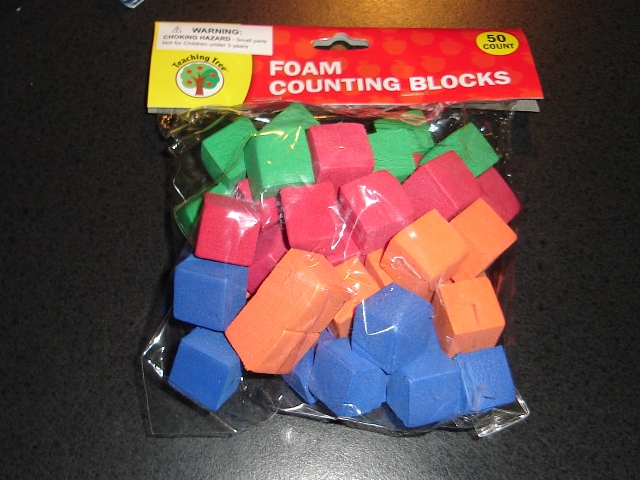 The base of this project, well, is just a 6"x6" piece of thin carboard. It's a base,
get it? OK ... sorry. But the real "base" piece is the pictured "foam counting cubes".
I got this bag at the Dollar Tree for ... you guessed it ... a dollar. Well, actually,
my wife got me a dozen for $12. Potayto. Potahto.
The base of this project, well, is just a 6"x6" piece of thin carboard. It's a base,
get it? OK ... sorry. But the real "base" piece is the pictured "foam counting cubes".
I got this bag at the Dollar Tree for ... you guessed it ... a dollar. Well, actually,
my wife got me a dozen for $12. Potayto. Potahto.
Based on fifty of these guys in a bag, I decided to go with about 12 per board. A few boards might get more, a few less. Since this is making ruins, I decided this might be a good opportunity to get rid of those cut up figure bits that I have been keeping because "I could make something with that". By combining the figures with plastic bottlecaps, you get statues ... or rather broken statue ruins.
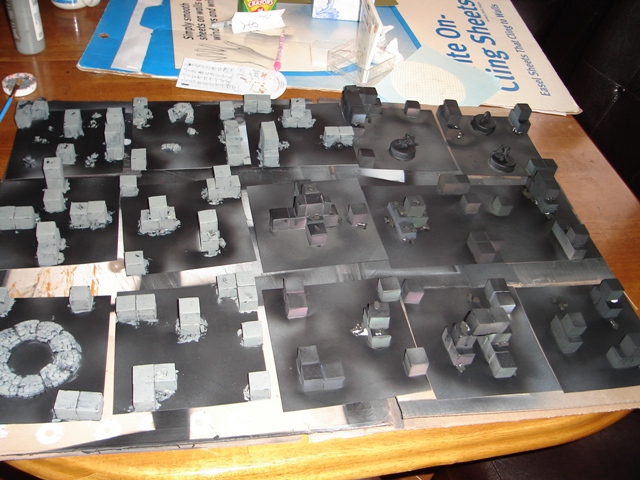 The blocks are just guled on with PVA - regular old cow glue. You could use something
stronger, but after priming black, painting, and sealing, they stand up to basic
wargming abuse fairly well. One of the keys to assembling them is that the ones I got
are not an "integral" size - not whole inches or centimeters. This is good as it forces
you go struggle and futz a bit with aligning things. It also helps in the end product.
Since the bases are all a standard size, being a bit off in alignment from board to board
keeps it from looking like a giant piece of graph paper.
The blocks are just guled on with PVA - regular old cow glue. You could use something
stronger, but after priming black, painting, and sealing, they stand up to basic
wargming abuse fairly well. One of the keys to assembling them is that the ones I got
are not an "integral" size - not whole inches or centimeters. This is good as it forces
you go struggle and futz a bit with aligning things. It also helps in the end product.
Since the bases are all a standard size, being a bit off in alignment from board to board
keeps it from looking like a giant piece of graph paper.
I also threw some little "bricks" in there. I used some self adhesive foam shapes that I had cut into small rectangles.
After assembling and priming comes painting. I started with a dark grey base coat for the blocks. Don't be too precise ... let the primer show through for cracks and texturing. Also, doing the gray first means you can slop it on the ground, since that will get painted over. I painted over the ground with just regular old Apple Bottom craft paint that I had mixed a little talus and a little dirt (like, from the ground outside) into. Again, don't sweat detailing in corners. Black showing through a bit is OK. so is a little (not a lot) of brown up the sides of the rocks. I did a couple of different layers of light drybrushing with light grays and light browns. Then I gave the whole thing a bath in black wash.
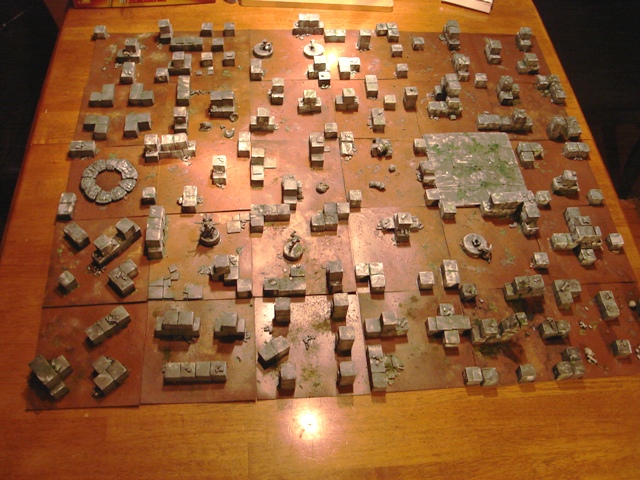 Before using spray sealant on them, I scattered some flock down. This is like a twofer
since the sealant glues down the flock for you.
Before using spray sealant on them, I scattered some flock down. This is like a twofer
since the sealant glues down the flock for you.
This is how they come out. If you have worked with thin card before, then, yep it does warp a little bit during this process. Fortunately, it is thin card, so you can just bend it back. No worries.
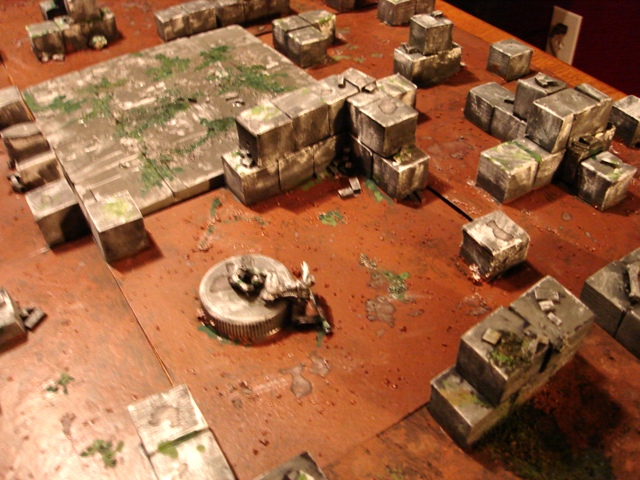
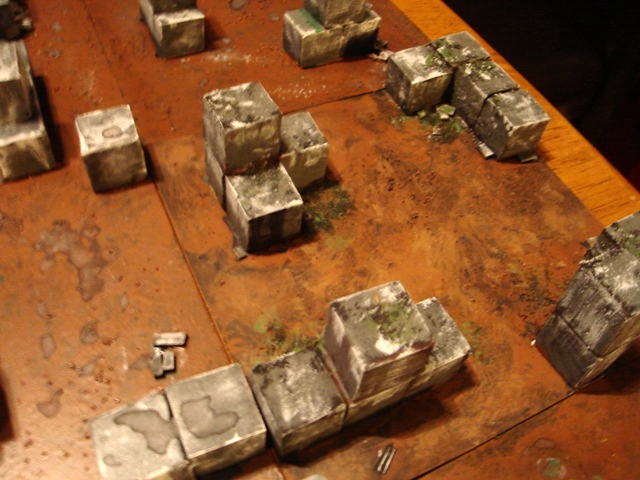 Playing a "sinking Atlantis" game with these pieces is pretty simple. First, you need
to pick a combat system, like
QILS
to let your figures fight. Then you build a board. It is important that the number
of pieces in the board is equal to the number of players, plus one. That way, when
you go around the board removing pieces, there ends up with one left and everyone
gets to remove the same number of pieces.
Playing a "sinking Atlantis" game with these pieces is pretty simple. First, you need
to pick a combat system, like
QILS
to let your figures fight. Then you build a board. It is important that the number
of pieces in the board is equal to the number of players, plus one. That way, when
you go around the board removing pieces, there ends up with one left and everyone
gets to remove the same number of pieces.
Our guidelines are:
- Three players - 16 pieces in a 4x4 grid
- Four players - 25 pieces in a 5x5 grid
- Four players - 29 pieces in a 5-6-7-6-5 "hex"
- Five players - 36 pieces in a 6x6 grid
- Six players - 25 pieces in a 5x5 grid
The ruin pieces should add a lot of variability to the terrain. We usually have a standard one-die QILS figure, which can move 6" and attack, or sprint 8" without attacking. We say a one block high wall reduces movement by 2" to cross and provides one level of obscurance (cover). A two block high wall blocks movement and line of sight.
The player who would look the most natural with gills goes first. Play then proceeds around clockwise. For the first round (each player's first turn), no board pieces are removed. After that, each player removes one "outside" piece after he is done using figures. An outside piece is one that has at least one full edge not touching another board piece. This continues until there is only one board piece left.
Any surface other than the board pieces is water. If a figure starts its turn in water, it looses ~25% of its move. If a figure ends its turn in water, it is removed from the board.
Play continues to last figure standing, which can sometimes take a few turns past the point where there is only one board piece left.
Here is a .pdf rule sheet you can grab and use. One version has terrain effect numbers in it, and one has blanks, so you can fill in your own.
And here is a ~3MB slideshow of a game in play for no apparent reason.
Enjoy!